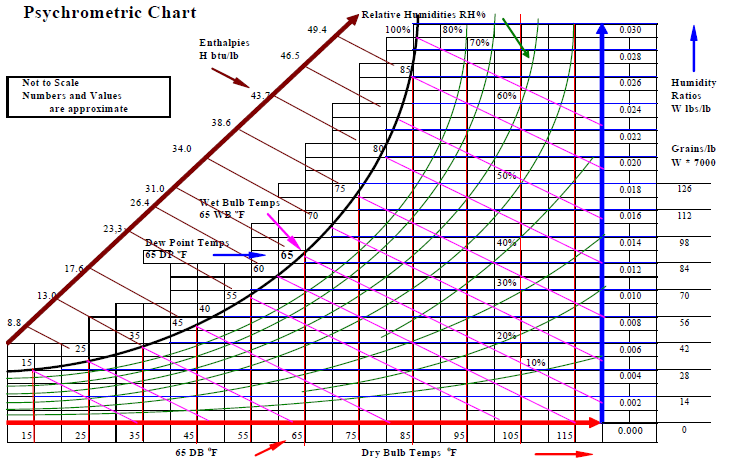

Inlet moisture H1 = 78 gr/lb dry airExit moisture H2 = 19 gr/lb dry air The path followed on a psychrometric chart is shown in Fig. Then qa = h2 h1 + hw= 34.08 33.88 + 0.2 = 0Įxample 5: Cooling and Dehumidification Find the cooling loadper pound of dry air resulting from infiltration of room air at 80F dry-bulb tem-perature and 67F wet-bulb temperature into a cooler maintained at 30F dry-bulb and 28F wet-bulb temperature, where moisture freezes on the coil, whichis maintained at 20F. = 33.88 Btu/lb dry airExit enthalpy h2 = h2 + D2 = 34.1 0.02Įnthalpy of added water hw = 0.2 Btu/lb dry air (from small diagram,37 gr at 70F) H = 37 gr/lb dry airInlet enthalpy h1 = h1 + D1 = 34.1 0.22 Inlet moisture H1 = 70 gr/lb dry airExit moisture H2 = 107 gr/lb dry air The only change in enthalpy is thatfrom the heat content of the makeup water. Since thespray water enters at the wet-bulb temperature of 70F and there is no heatadded to or removed from it, this is by definition an adiabatic process and therewill be no change in wet-bulb temperature. The leavingdry-bulb temperature is obtained directly from Fig. Figure 12-8 shows the path on a psychrometric chart. Determine exit dry-bulb temperature, wet-bulb tempera-ture, change in enthalpy of the air, and quantity of moisture added per pound ofdry air. The spray water is recirculated makeupwater enters at 70F. Figure 12-7 shows the heatingpath on the psychrometric chart.Įxample 4: Evaporative Cooling Air at 95F dry-bulb temperatureand 70F wet-bulb temperature contacts a water spray, where its relativehumidity is increased to 90 percent. Qa = h = h2 h1 = 21 10.16 = 10.84 Btu/lb dry airIf the enthalpy deviation is ignored, the heat added qa is h = 21.1 10.1 = 11Btu/lb dry air, or the result is 1.5 percent high. The heat added equals the enthalpy difference, or The enthalpy of the inlet air is obtained from Fig. Relative humidity = 15 percentWet-bulb temperature = 51.5F


 0 kommentar(er)
0 kommentar(er)
